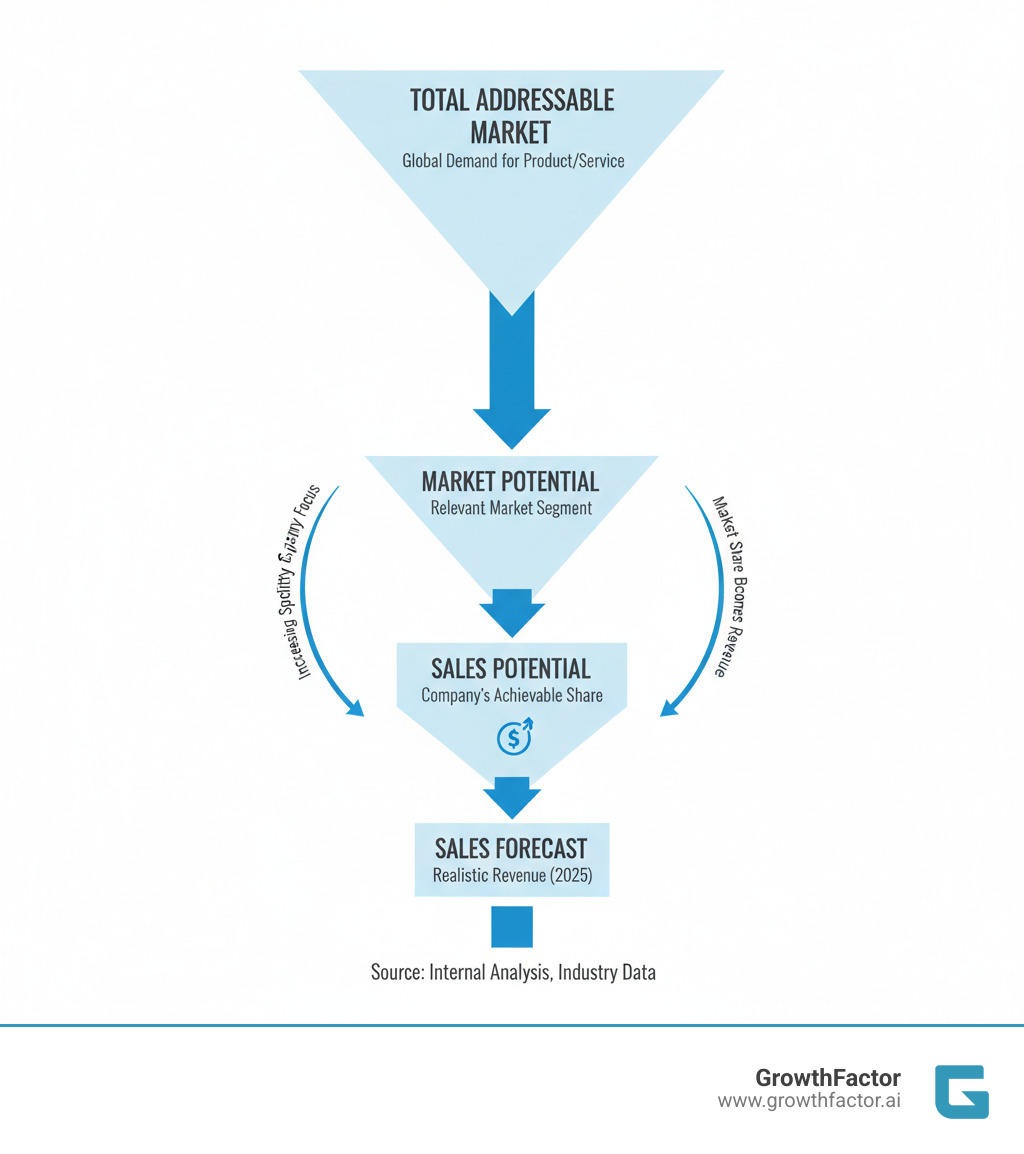Market Potential Analysis: Your Roadmap to Understanding Demand
Why Sales Potential Analysis is Essential for Strategic Growth

Sales potential analysis estimates the maximum revenue a business can achieve from a specific product or market in a set period. Here's what you need to know:
Quick Answer: How to Perform Sales Potential Analysis
- Identify your target market - Define the total addressable market and potential customers
- Gather critical data - Collect internal sales data, market demographics, and competitor information
- Choose a calculation method - Use either top-down (market share) or bottom-up (capacity-based) approaches
- Calculate your potential - Apply formulas: Market Size × Market Share % OR Sales Units × Capacity per Unit
- Validate and refine - Cross-reference results with industry benchmarks and historical performance
- Apply insights strategically - Use findings to guide expansion, resource allocation, and growth planning
Making expansion decisions on gut feeling is risky, as a single poorly-located store can cost hundreds of thousands in lost revenue. Sales potential analysis transforms this guessing game into a strategic science. It provides a data-driven framework to answer key questions: Which markets offer the highest return? Where should you open new stores? What revenue can you expect from a new territory?
Data-driven analysis leads to outperformance, yet only 27% of sales teams are highly confident they understand their customers' needs. For fast-growing retail chains juggling multiple site evaluations, traditional methods like spreadsheets and manual lookups are too slow.
This analysis provides a consistent framework to evaluate opportunities, allocate resources, and build a strong business case for investors. It’s the key to strategic, not blind, expansion. Modern analysis combines proven methods with technology like AI for greater accuracy, but the fundamentals of market research and competitive intelligence remain.
As founder of GrowthFactor.ai, I've used sales potential analysis to help retailers open 550+ locations with a 99.8% success rate. It's the core of every successful expansion strategy.

Sales potential analysis vocab explained:
The Crucial Difference: Sales Potential vs. Market Potential vs. Sales Forecasting
To master sales potential analysis, distinguish it from market potential and sales forecasting.
| Dimension | Sales Potential | Market Potential | Sales Forecasting |
|---|---|---|---|
| Scope | Company-specific: The maximum sales your company can achieve for a product/service. | Entire Market: The total maximum sales all companies in a market can achieve. | Company-specific: The expected actual sales your company will achieve. |
| Purpose | Strategic Planning: Identifies ultimate growth ceiling, market entry, product prioritization. | Market Opportunity Assessment: Defines the overall size and attractiveness of a market. | Operational Planning: Guides budgeting, resource allocation, setting realistic targets. |
| Timeframe | Long-term (often theoretical maximum over a sustained period, but can be defined for shorter strategic periods). | Long-term (the ultimate demand ceiling for a market). | Short-to-medium term (typically next quarter, year, or 2-3 years). |
| Key Question | "What could we sell?" | "What could the entire market sell?" | "What will we sell?" |
| Influencing Factors | Market demand, competition, company capacity, product-market fit, pricing, distribution. | Total market size, consumer needs, economic conditions, technological advancements, regulatory environment. | Historical sales, current pipeline, marketing campaigns, economic outlook, competitive actions, sales team performance. |
Market potential is the total demand across all competitors. Sales potential is your company's achievable slice of that pie. In contrast, sales forecasting predicts what you will sell based on current operations and historical data; it's typically lower than your sales potential. For more, see our Sales Forecasting Tips for Retail Site Selection.
The Benefits of Understanding Your Sales Potential
Calculating your sales potential is a powerful tool for growth. Benefits include:
- Improved ROI: Focus resources on high-potential areas.
- Informed Decision-Making: Use data, not gut feelings, for market entry and product development.
- Attracting Investors: Show a realistic, data-backed growth plan.
- Performance Benchmarking: Compare actual sales to potential to find improvement areas.
- Identifying Growth Opportunities: Uncover untapped markets with high demand.
- Setting Realistic Goals: Set achievable targets for sales teams.
- Better Resource Allocation: Deploy teams and budgets for maximum impact.
- Risk Mitigation: Identify risks before committing significant resources.
Many businesses struggle with this; only 27% of sales teams feel confident they understand customer needs. This gap hinders growth. A robust sales potential analysis provides the necessary precision to bridge it.
Key Factors and Data Sources for Accurate Analysis
Accurate sales potential analysis requires a solid data foundation. Successful retailers combine external market dynamics with internal capabilities for a complete picture of achievable revenue.

External Factors That Shape Your Potential
External factors define the boundaries of your sales potential, setting the stage for what's possible.
- Market size: How many potential customers exist in your target area? A bigger market means higher potential.
- Consumer demand: Are people actively seeking what you offer? High demand creates opportunities for greater sales volumes. The Consumer Spending data from the Bureau of Economic Analysis helps gauge these trends.
- Economic conditions: Disposable income, employment, and inflation influence customer spending. A thriving economy boosts potential.
- Seasonality: Sales can fluctuate based on the season, weather, or budget cycles. Acknowledging this prevents inventory and staffing issues.
- Competition: Who else is vying for your customers? Their strategies affect your achievable market share. The SBA's guide on Market research and competitive analysis | U.S. Small Business ... offers frameworks for this.
- Regulatory changes: New laws, trade policies, or zoning can create restrictions or costs that impact potential.
Internal Data and Market Insights
While external factors define the market, your internal capabilities determine your success within it.
- Historical sales data: Your past results reveal patterns and growth rates that inform realistic projections.
- Sales team capacity: Your team's size, close rates, and deal sizes set hard limits on what you can achieve.
- Marketing effectiveness: Strong campaigns generate and capture demand. Measuring marketing ROI helps you understand how much potential you can realize.
- Product-market fit: A strong fit between your product and customer needs creates organic demand and fundamentally shapes your achievable sales potential.
An honest self-assessment of your market share, growth rate, and pricing reveals areas for improvement. Our guide on Retail Market Research explores this further.
Essential Data Sources for Your Analysis
A robust sales potential analysis requires diverse, reliable data sources, many of which are free and accessible.
- CRM system: Your first stop for internal data on customer interactions, pipeline, and revenue trends.
- Industry reports: Offer broad perspectives on market size, growth, and competitive dynamics.
- Government statistics: The U.S. Census Bureau and Bureau of Labor Statistics provide free, valuable data on demographics and spending.
- Market research surveys: Fill knowledge gaps about pricing sensitivity or unmet needs with primary research like surveys and focus groups.
- Foot traffic data: Indispensable for retail, this data helps estimate sales potential for physical stores. Our Foot Traffic Analysis Complete Guide explains how to use it.
- Financial reports: Your own and competitors' reports provide insights into revenue, profitability, and growth trajectories.
The key is to combine these diverse sources. Integrating internal metrics, external data, and competitive intelligence creates a comprehensive framework for smarter decisions.
How to Calculate Sales Potential: Methods and Formulas
With data in hand, it's time to calculate your sales potential. There are two primary methods, often used together, to estimate what's achievable.

Method 1: The Top-Down Approach (Market Share)
The top-down method starts with the total market and estimates your share. It's ideal for new markets where you lack historical data.
First, determine the total addressable market (TAM)—the total revenue for your category in a specific area. For retail locations, this involves analyzing trade area demographics. Our Site Demographics Complete Guide explains this process. Next, estimate your achievable market share based on competitive analysis, brand strength, and marketing capabilities.
The formula is simple:
Sales Potential = Total Market Size × Estimated Market Share %
For example, a new coffee shop in a Cambridge, MA neighborhood with a $5,000,000 total annual coffee market estimates it can capture a 5% share. Its sales potential is $5,000,000 × 0.05 = $250,000.
Method 2: The Bottom-Up Approach (Capacity-Based)
The bottom-up approach starts with your internal capabilities and builds up. It's often more accurate for established businesses with performance data.
Identify your core sales units (e.g., sales reps, stores) and calculate the maximum sales capacity for each, based on top performers under optimal conditions.
The formula is also straightforward:
Sales Potential = Number of Sales Units × Capacity per Unit
For example, a retail chain opening 10 new stores knows its top-performing locations generate $1,500,000 annually. The sales potential is 10 stores × $1,500,000/store = $15,000,000. This is invaluable for Data-Driven Site Selection.
Key Metrics for a Granular Sales Potential Analysis
For a more granular sales potential analysis, dig deeper into these key metrics:
- Market penetration rate: Your current customers divided by total potential customers. Low penetration indicates high growth potential.
- Customer purchasing capacity: The maximum a customer could spend with you. Comparing this to actual spending reveals upsell opportunities.
- Average deal size: The typical revenue per transaction, which helps translate customer numbers into revenue.
- Sales velocity: How quickly deals move through your pipeline. Higher velocity means faster revenue realization.
- Close rate by segment: Conversion rates by customer type or product line, helping focus resources on high-converting segments.
All calculations rest on assumptions (e.g., stable economy, current staffing). Acknowledge them explicitly. These are estimates, not guarantees. Markets change, so revisit your sales potential analysis quarterly, treating it as a living tool.
Strategic Applications: Turning Potential into Profitable Growth
Calculating sales potential is the first step. The next is turning those numbers into strategic decisions that drive growth.

Think of this analysis as a business GPS, showing you profitable routes, helping you avoid dead ends, and highlighting missed opportunities.
Using Sales Potential Analysis to Identify New Markets
For retailers, choosing where to expand is a high-stakes decision. Sales potential analysis replaces guesswork with data-backed choices.
- Identifying untapped regions: Layer market size data with competitive density to find "goldilocks zones" with high demand and low competition.
- Assessing market viability: Go beyond surface appeal to see if a location's demographic profile, local economy, and foot traffic can support your revenue targets.
- Prioritizing expansion efforts: Objectively rank multiple potential markets by calculating the sales potential for each, avoiding choices based on personal preference.
- Minimizing risk: Understand your breakeven point, upside potential, and the market conditions required for success before you invest.
Example: A fitness chain used this analysis to expand. Connecticut seemed attractive due to high incomes but was oversaturated. The analysis revealed that certain Rhode Island markets had strong demographics and less competition, making them the better choice. This data-driven decision might have been missed otherwise. Our guide on How to Choose Retail Location details this framework.
Prioritizing Products and Allocating Resources
Sales potential analysis also helps optimize your product portfolio and resource investment, moving beyond the "we've always done it that way" mindset.
- Focusing on high-potential offerings: Identify which products have the most untapped market potential and shift resources accordingly.
- Guiding product roadmaps: Evaluate new features against potential market impact, not just development cost or the requests of a few loud customers.
- Allocating marketing budgets effectively: Reallocate budget from saturated segments to high-potential ones to improve marketing ROI.
- Optimizing sales team focus: Direct your sales team to the territories, accounts, or segments with the highest potential for success. For more, explore our Site Selection Strategy resources.
The common thread is a shift from reactive to proactive. It enables strategic investment based on data, not hope.
The Future of Sales Potential Analysis: The Role of AI and Technology
Sales potential analysis has transformed. What once took weeks of manual work can now be done in hours with greater accuracy, thanks to modern technology.
This shift is powered by AI and advanced analytics. In fact, 83% of sales teams using AI saw revenue growth, a significant jump from the 66% using traditional methods, per Salesforce's State of Sales report. These tools are now essential to stay competitive.
For retail real estate, this is transformative. AI platforms can instantly analyze demographics, foot traffic, and competition across multiple markets, providing insights in minutes that once took weeks. These tools are now accessible to smaller chains, leveling the playing field with large corporations.
How AI and Predictive Algorithms Improve Your Sales Potential Analysis
Machine learning algorithms find hidden patterns in vast datasets—including sales history, demographics, and economic indicators—that are impossible for human analysts to process manually.
- Predictive accuracy improves dramatically: AI models incorporate hundreds of variables and adapt as new data arrives, making predictions more accurate than traditional methods.
- Automation of data collection eliminates tedious manual work, saving hours and ensuring data consistency.
- Dynamic peer group analysis: AI can instantly identify similar existing locations based on dozens of characteristics to project realistic sales potential for a new site.
- Opportunity scoring ranks potential sites or territories based on their projected value, helping you focus on the top prospects. Our guide on AI Location Intelligence explores how these algorithms work.
Leveraging CRM and Location Intelligence Software
The magic happens when you connect internal CRM data with external market intelligence. Your CRM holds your performance history, which is invaluable for understanding capacity.
Location intelligence software adds the crucial geographic dimension. Visualizing data on maps reveals patterns invisible in spreadsheets, like store clusters, underserved neighborhoods, and foot traffic flows. For retail, integrating foot traffic with demographic data provides a comprehensive picture of a location's sales potential. This granular understanding of visitor behavior dramatically improves site selection accuracy.
GrowthFactor's Location Intelligence Software and Retail Site Selection Software integrate these capabilities into one platform for retail real estate, eliminating the need to juggle multiple tools.
Tracking is also key. Monitor actual performance against potential in real-time to identify underperforming areas and validate assumptions. This allows you to refine future analyses.
Frequently Asked Questions about Sales Potential Analysis
How does seasonality impact sales potential calculations?
Seasonality significantly impacts sales potential calculations. For short-term planning (e.g., quarterly), you must adjust for seasonal peaks and valleys to manage inventory and staffing correctly. For long-term, annual analysis, these fluctuations tend to smooth out. The best practice is to calculate annual potential first, then apply seasonal adjustments for operational planning. Understanding your unique seasonal patterns is key to setting realistic goals and avoiding costly mistakes.
What is the role of market analysis in determining sales potential?
Market analysis is the foundation of sales potential. It provides essential external context, helping you understand market size, competitive landscape, and your potential market share. It uncovers differentiation opportunities, as emphasized by resources like MySBA Learning, and provides benchmarks to gauge performance. If you're performing below industry averages, there's room to grow. Continuous market analysis also helps you anticipate market shifts, allowing you to proactively adjust your strategy.
What are the biggest limitations of sales potential estimates?
Sales potential estimates are powerful but have limitations. They are estimates, not guarantees, and their accuracy depends on data quality—garbage in, garbage out. Market conditions are also dynamic; a new competitor or economic shift can quickly change your potential. The analysis also assumes ideal internal performance, which is rarely the case. Because of these factors, sales potential analysis is not a one-time task. It requires regular reassessment, at least quarterly, to remain relevant and adapt to changing realities.
Conclusion: From Potential to Performance
We've explored what sales potential analysis is, how to calculate it using top-down and bottom-up methods, and how technology is making it more dynamic and precise.
The key takeaway is that guessing is no longer an option in today's competitive retail landscape. Sales potential analysis provides the clarity needed to make confident decisions about market entry, resource allocation, and expansion. This shift from intuition to insight is transformative, enabling confident, strategic expansion backed by solid projections.
For retail real estate, this data-driven approach is essential. GrowthFactor's platform was built for this, using AI and location intelligence to consolidate demographic, foot traffic, and competitive data. Our goal is to help you understand the opportunity before you invest.
Knowing your sales potential directly impacts your bottom line, differentiating thriving stores from struggling ones and ensuring you hit your growth targets.
While not about perfection, this analysis gives you a fighting chance to make smarter bets, avoid costly mistakes, and focus your energy effectively.
Understanding your sales potential is the starting point for strategic growth. It’s about turning data into decisions that drive profitable, sustainable performance.
Citations
The human algorithm
Request a live demo
Schedule meeting
Or submit your information below and we'll be in touch to schedule.


